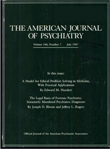The dexamethasone suppression test in outpatients with primary affective disorder and healthy control subjects
Abstract
The authors report data on the overnight dexamethasone suppression test (DST) from 64 patients with primary affective disorder (41 unipolar, 17 bipolar-depressed, and 6 bipolar-hypomanic) and 53 healthy control subjects. No difference between the patients and controls was noted in baseline 8:00 a.m. serum cortisol levels or in cortisol levels obtained after the administration of 1 mg of dexamethasone. Sixteen patients and 8 controls had 4:00 p.m. postdexamethasone cortisol levels higher than 5.0 micrograms/dl. The distribution of suppressors and nonsuppressors did not differ significantly between the two groups. Patient nonsuppressors had significantly higher baseline cortisol levels than did patient suppressors (p less than .001). Clinical parameters and family history data did not distinguish patient suppressors from nonsuppressors.
Access content
To read the fulltext, please use one of the options below to sign in or purchase access.- Personal login
- Institutional Login
- Sign in via OpenAthens
- Register for access
-
Please login/register if you wish to pair your device and check access availability.
Not a subscriber?
PsychiatryOnline subscription options offer access to the DSM-5 library, books, journals, CME, and patient resources. This all-in-one virtual library provides psychiatrists and mental health professionals with key resources for diagnosis, treatment, research, and professional development.
Need more help? PsychiatryOnline Customer Service may be reached by emailing [email protected] or by calling 800-368-5777 (in the U.S.) or 703-907-7322 (outside the U.S.).



